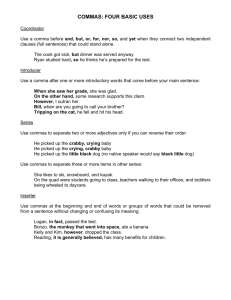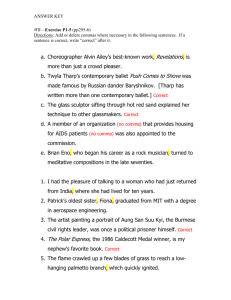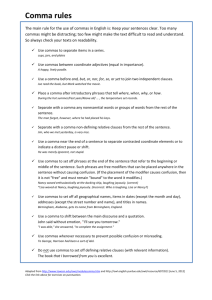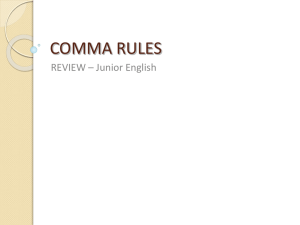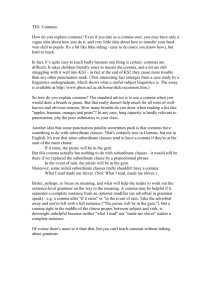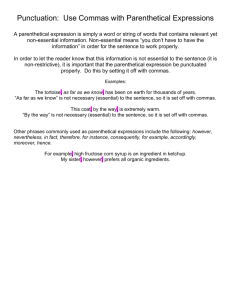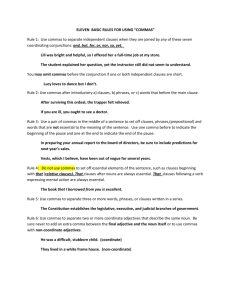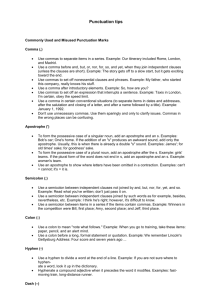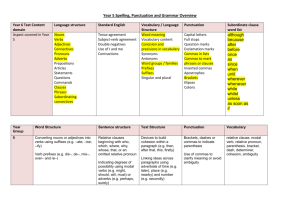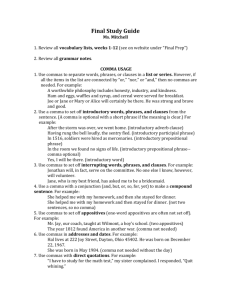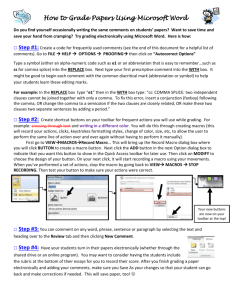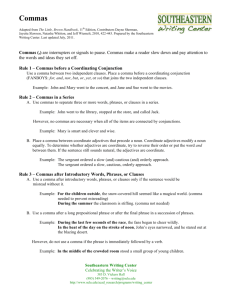Commas 101: The Basics - The Evergreen State College
advertisement
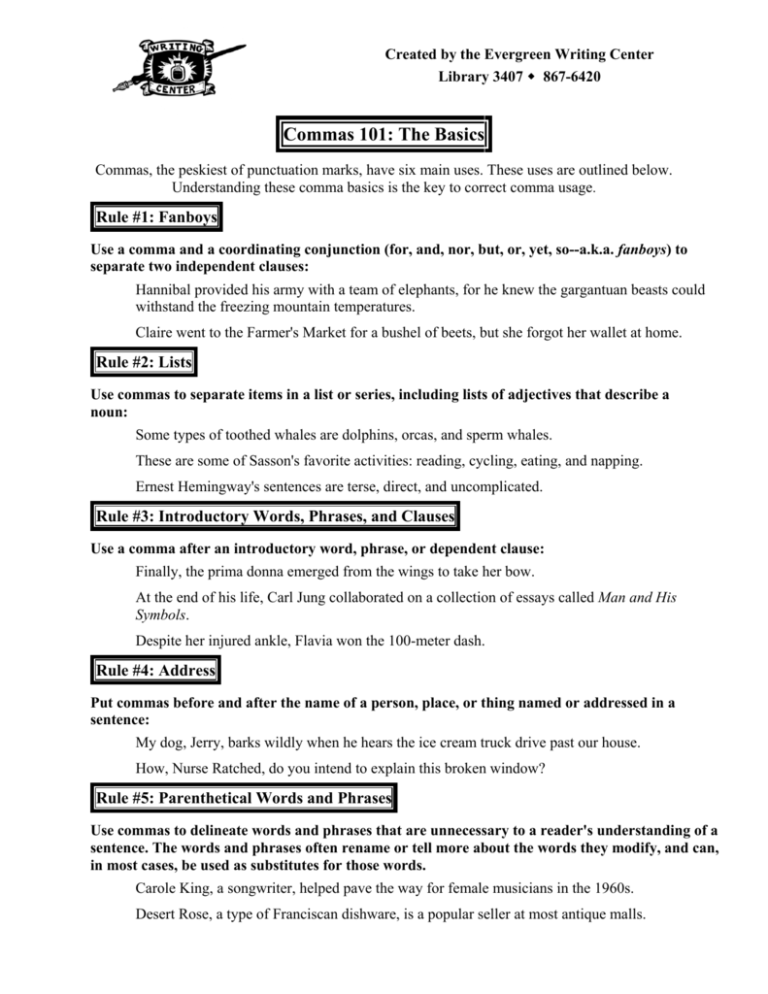
Created by the Evergreen Writing Center Library 3407 867-6420 Commas 101: The Basics Commas, the peskiest of punctuation marks, have six main uses. These uses are outlined below. Understanding these comma basics is the key to correct comma usage. Rule #1: Fanboys Use a comma and a coordinating conjunction (for, and, nor, but, or, yet, so--a.k.a. fanboys) to separate two independent clauses: Hannibal provided his army with a team of elephants, for he knew the gargantuan beasts could withstand the freezing mountain temperatures. Claire went to the Farmer's Market for a bushel of beets, but she forgot her wallet at home. Rule #2: Lists Use commas to separate items in a list or series, including lists of adjectives that describe a noun: Some types of toothed whales are dolphins, orcas, and sperm whales. These are some of Sasson's favorite activities: reading, cycling, eating, and napping. Ernest Hemingway's sentences are terse, direct, and uncomplicated. Rule #3: Introductory Words, Phrases, and Clauses Use a comma after an introductory word, phrase, or dependent clause: Finally, the prima donna emerged from the wings to take her bow. At the end of his life, Carl Jung collaborated on a collection of essays called Man and His Symbols. Despite her injured ankle, Flavia won the 100-meter dash. Rule #4: Address Put commas before and after the name of a person, place, or thing named or addressed in a sentence: My dog, Jerry, barks wildly when he hears the ice cream truck drive past our house. How, Nurse Ratched, do you intend to explain this broken window? Rule #5: Parenthetical Words and Phrases Use commas to delineate words and phrases that are unnecessary to a reader's understanding of a sentence. The words and phrases often rename or tell more about the words they modify, and can, in most cases, be used as substitutes for those words. Carole King, a songwriter, helped pave the way for female musicians in the 1960s. Desert Rose, a type of Franciscan dishware, is a popular seller at most antique malls. Created by the Evergreen Writing Center Library 3407 867-6420 Rule #6: Parenthetical Dependent Clauses Use commas to offset parenthetical dependent clauses. These clauses usually give more information about the word or words they modify, and cannot replace those words because they are not complete sentences. Often, these clauses begin with pronouns, e.g. who, which, whose, etc. Margaret, who starred in the school play, is planning to be an actress. Pablo Picasso, whose paintings are known for their multiple perspectives, was a forerunner of the Cubist movement. Emily dreams of travelling to Paris, which is called the City of Light, because she loves baguettes and accordion music. Note: It is sometimes easy to tell where to place a comma if you read your writing aloud. Natural pauses often signal the need for a comma. However, this is NOT a foolproof method; you can always refer to this handy-dandy handout or another grammar guide, such as Diana Hacker's A Writer's Reference or Glazier & Wilson's The Least You Should Know About English, if you have a question. And remember: when in doubt--leave it out! Exercise Read through the following excerpt from Sherwood Anderson's Winesburg, Ohio with a partner. Some sentences contain comma errors. Some commas are misplaced; some commas are missing. With your partner, find the comma errors and fix them. Remember to use the preceding six rules to help guide your corrections. A Man of Ideas He lived with his mother a grey silent, woman with a peculiar ashy complexion. The house in, which they lived stood in a little grove of trees beyond where the main street of Winesburg crossed Wine Creek. His name was Joe Welling, and his father had been a man of some dignity in the community a lawyer and a member of the state legislature at Columbus. Joe himself was small of body and in his character unlike anyone, else in town. He was like a tiny little volcano that lies silent for days and then suddenly spouts fire…Words rolled and tumbled from his mouth. A peculiar, smile came upon his lips. The edges of his teeth that were tipped with gold glistened in the light. Pouncing upon a bystander he began to talk. For, the bystander there was no escape. For more practice, choose a passage from a book, newspaper, or magazine you are reading. Find the commas. Are any commas misplaced? Are any commas missing? What rule does each comma follow? By analyzing other writers' comma usage, you can improve your understanding of when--and how--to use commas.
